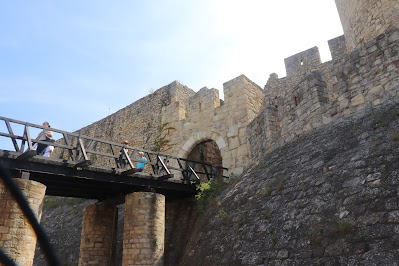 |
| Great Synagogue |
We took the optional tour to explore the Jewish Heritage of
Hungry. Today, Budapest still has 100,000 Jews, one of the largest populations
in Europe. From 1696, for over 200 years, Jews couldn’t live in the city. In
1840, Jews could buy land in the city. They were granted equal rights in the
Hungarian empire in 1867. We went to the Great
Synagogue with its Moorish external design, one of 23 synagogues in
Budapest. With over 3000 seats, it is the world’s second largest. The synagogue
serves about a 100 each sabbath but does fill for the high holy days. It was
built in 1859 as the first Neolog branch of
Judaism.
 |
| Interior of Great Synagogue |
Breaking from the Orthodox
branch. They removed the curtain separating men and women, they moved the
reading platform from the center of the synagogue to the front. This synagogue
isn’t square but looks like a church. It also has an organ (technically it is
outside the synagogue since it is behind the ark of the covenant). It is also
so played by a non-Jew, since Jews can’t work on the Sabbath. Franz Liszt played
at the inauguration. Before World War Two, Hungary had 800,000 Jews. Since
Hungary sided with Germany, they were not invaded by the Nazis at the start of
World War II. But 2000 Nazi soldiers came in March 1944 and by June they had
sent 400,000 Jews to the death camps. The Nazis were ready to deport the Jews
in Budapest, Regent Horthy stopped the operation. But the Hungarian Army
isolated the Jews in a ghetto and began shooting Jews. In December 1944, the Germans
retreated to Buda and destroyed all the bridges. It took 6 weeks for Soviet
troops to reach Buda and the Jews were left without food or heat. 10,000 corpses
were found by the Soviets. Next to the synagogue is the Holocaust Memorial
Garden and Cemetery.
We also visited the Hero’s Temple built in 1931 commentating
the Jews who fought for Hungary during World War I. Outside is the Weeping
Willow shaped like a menorah. It commemorates the 400,000 Hungarian Jews who murdered during the Holocaust. Nearby is a memorial to the diplomats and others
who protected the Hungarian Jews from the Holocaust who provided documentation
like passports and baptism certificates.
 |
| Weeping Willow Memorial |
We then visited the Rumbach Street Synagogue built in 1869
by those who wanted to be more conservative. After WW II, this synagogue lost
half its congregation, then in 1956, it lost its Rabbi, it closed in 1960. The
Hungarian government refurbished the synagogue in 2022 as a synagogue, but also
to provide education to all. The reading platform descends under the floor to
provide a lecture and performance space. There are also classrooms attached to
the building.
In the afternoon, we walked the Buda Castle area. Climbing
the hill to the Fisherman’s Bastion, originally the ancient city walls defended
by the fisherman’s guild. Nearby is St. Steven’s Statue, the first king of
Hungary from 1000 to 1038 AD. Mathias Church has a beautiful tile roof. Many
royal coronations have occurred here.
 |
| St. Mathias Church |
That night we waited for dark to appear, so we could so the monuments of Budapest lit up at night!
Autocracy in Hungary
Our lecturer, Dr. Kate, wanted us Americans to learn from Hungary’s
experience how easy it is for a democracy to become a dictatorship. After the Berlin
Wall fell, Hungary had two free elections, but all have been rigged since then.
Victor Orbán has
won 2/3rds of the vote since 2006. How? It started with a coup that was led by football
players, who called for new elections and then relied on character
assassination to win. From there, they took over the free press: newspapers,
radio, and TV. If a citizen only knows Hungarian, his only news source is the government.
Listening to these sources today, Hungary's biggest problem is gender change in
kindergarten. Then the Hungarian government offered Hungarian citizenship to anyone
with Hungarian heritage who lived in other countries (4 to 5 Million). Since
Hungary had EU membership, this offered employment to any Eastern Europe
countries, who weren’t EU members. Finally they added voting privileges to
these foreigners. Then the legislature required constitutional judges to retire
at age 45, so they could completely replace the court. The 200-year-old
constitution was dumped and replaced by one written by one person on a 3 hour
train ride. Hungary, a member of the European Union and NATO, has leadership
that is anti-EU, and pro-Putin. Joining the EU or NATO requires unanimous
consent of the current countries, Hungary has accepted funding to not veto recent
entries.




































